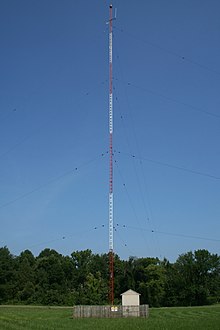
Back Antena monopol Catalan Monopolantenne Danish Groundplane-Antenne German Monopolo vertical Spanish آنتن تکقطبی Persian Maatasoantenni Finnish Antenne monopôle French אנטנת מונופול HE Antenna a monopolo Italian Marconi-antenne Dutch

A monopole antenna is a class of radio antenna consisting of a straight rod-shaped conductor, often mounted perpendicularly over some type of conductive surface, called a ground plane.[1][2] The current from the transmitter is applied, or for receiving antennas the output signal voltage to the receiver is taken, between the monopole and the ground plane. One side of the feedline to the transmitter or receiver is connected to the lower end of the monopole element, and the other side is connected to the ground plane, which may be the Earth. This contrasts with a dipole antenna which consists of two identical rod conductors, with the current from the transmitter applied between the two halves of the antenna. The monopole antenna is derived mathematically from the dipole. The vertical monopole is an omnidirectional antenna with a low gain of 2 - 5 dBi, and radiates most of its power in horizontal directions or low elevation angles. Common types of monopole antenna are the whip, rubber ducky, umbrella, inverted-L and T-antenna, inverted-F, folded unipole antenna, mast radiator, and ground plane antennas.
The monopole is usually used as a resonant antenna; the rod functions as an open resonator for radio waves, oscillating with standing waves of voltage and current along its length. Therefore the length of the antenna is determined by the wavelength of the radio waves it is used with. The most common form is the quarter-wave monopole, in which the antenna is approximately one quarter of the wavelength of the radio waves. It is said to be the most widely-used antenna in the world.[3][4] Monopoles shorter than one-quarter wavelength, called electrically short monopoles are also widely used since they are more compact. Monopoles five-eights (5/8 = 0.625) of a wavelength long are also common, because at this length a monopole radiates a maximum amount of its power in horizontal directions. A capacitively loaded or top-loaded monopole is a monopole antenna with horizontal conductors such as wires or screens insulated from ground attached to the top of the monopole element, to increase radiated power. Large top-loaded monopoles, the T and inverted L antennas and umbrella antenna are used as transmitting antennas at longer wavelengths, in the LF and VLF bands.
The monopole antenna was invented in 1895 by radio pioneer Guglielmo Marconi; for this reason it is also called the Marconi antenna although Alexander Popov independently invented it at about the same time.[5][6]
- ^ Bevelacqua 2016.
- ^ Straw 2000, p. 2.17.
- ^ Orfanidis 2016, p. 785.
- ^ Balanis 2005, p. 195.
- ^ Das 2016, p. 116.
- ^ Wong 2011, p. 94.